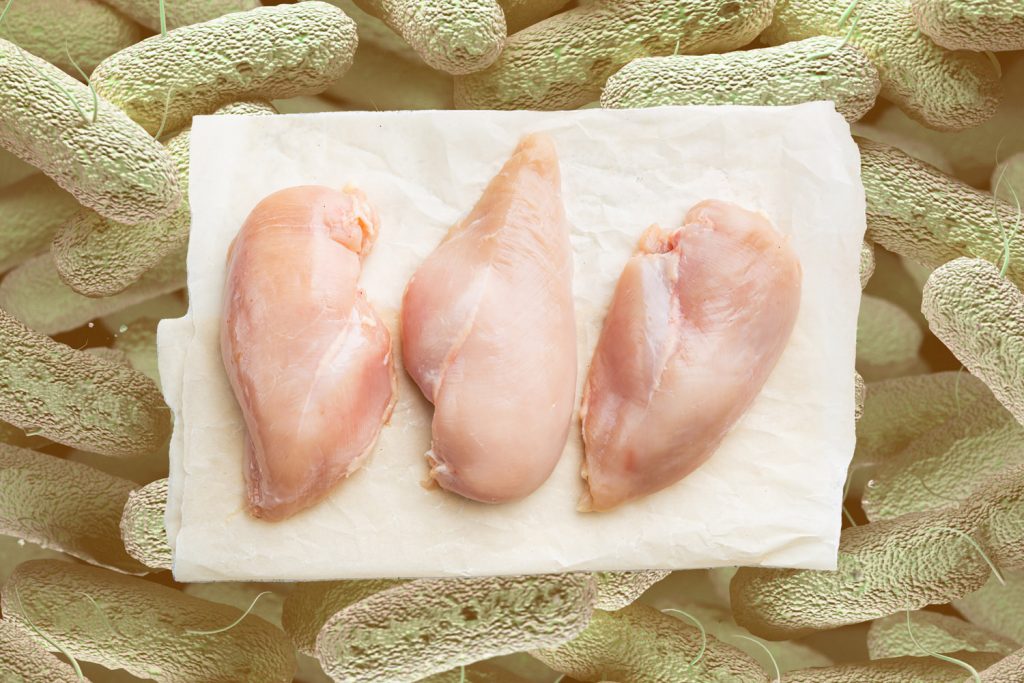11 Oct The gut-liver and the gut-brain axis: Gut flora influences fat deposition

Nowadays, consumers prefer lean meats, as a source of proteins and nutrients that does not increase cardiovascular risk.
In previous articles, we have explained that the metabolites produced by the intestinal flora regulate the functioning of other organs, such as lungs, liver and brain. In this blog, we will discuss how the microbiome is also involved in lipid absorption and fat deposition.
The gut-liver axis: Interaction between bile acids and gut flora
Fats arrive to the digestive tract in the form of big globules. In the small intestine, bile salts secreted by the gallbladder emulsify the globules and break them down into smaller particles, and making the lipids available for digestion by lipase, a pancreatic enzyme.
There is a two-way interaction between bile acids and gut flora:
- On one hand, bile acids have antimicrobial effects and regulate the species present in the microbiome.
- On the other hand, some bacteria are able to degrade bile acids: Cholic acid and chenodeoxycholic acid are the two most important bile acids, also called primary bile acids. Once in the intestinal lumen, they are transformed by bacterial enzymes to deoxycholic acid and lithocholic acid. respectively, which are called secondary bile acids. Both the primary and secondary bile acids are reabsorbed and circulate to the liver through the portal vein, where they regulate glucose and fat metabolism.
By determining the proportion of each primary and secondary bile acid present in the intestine, the microbiome regulates fat absorption. Additionally, in the liver, changes in the bile acids profile disrupt fat metabolism and lead to fatty liver.
The gut-brain axis: The role of short-chain fatty acids
Short-chain fatty acids (SCFAs) are small organic acids, with a chain length up to six carbons, produced by certain species of gut flora after the fermentation of dietary fibers and resistant starch. Acetate, propionate and butyrate are the most important. In addition to their very well-known role in gut health, there is growing evidence that they exert physiological effects on other organs.
SCFAs are involved in lipid metabolism as a substrate and also as regulators of metabolic processes, but their mechanism of action is complex and involves several physiological pathways. Some of their effects take place through the gut-brain axis and others in the intestinal lumen.
- SCFAs control appetite and feed intake, influencing the brain via the vagus nerve or when SCFAs are absorbed to the systemic circulation.
- By activating the parasympathetic nervous system, acetate increases the secretion of triglycerides.
- Acetate and butyrate act as substates for lipid synthesis in gut epithelial cells.
- By inhibiting certain genes located in the intestinal epithelium, SCFAs are involved in the storage of fats in adipocytes.
- Butyrate and propionate accelerate lipolysis (fat destruction) by inhibiting the enzyme histone deacetylase. Furthermore, SCFAs promote fatty acid oxidation and degradation.
Observations in poultry and swine
Secondary bile acids and SCFAs are not the only compounds produced by gut flora that are able to regulate fat metabolism. Amino acids and lipopolysaccharides (LPS, bacterial endotoxins that are able to cross the gut barrier) are examples of other substances that may be involved.
In swine:
- The administration of SCFAs reduces abdominal and hepatic fat, improves carcass traits, and increases meat quality.
- Certain gut bacteria produce branched-chain amino acids (valine, leucine, and isoleucine) and aromatic amino acids (phenylalanine, tyrosine, and tryptophan) that promote fat deposition in pigs.
- Acute inflammation caused by LPS disrupts the synthesis of triglycerides.
- Fatty pig breeds and lean pig breeds show different gut flora composition and lipid metabolic profiles.
In swine and poultry:
- Certain gut bacteria metabolize tryptophan to compounds that regulate fat metabolism. The supplementation with tryptophan reduces fat abdominal content and increases meat quality.
In poultry:
- The abundance of certain genus of bacteria (Klebsiella, Escherichia, among others) correlates with a high abdominal fat deposition in chickens and the expression of gens related to fat synthesis. On the other hand, other species of bacteria, such as certain Lactobacillus, reduce fat accumulation through the activation of fat catabolism.
- Subclinical necrotic enteritis increases fat production, resulting in lipid accumulation in the muscle.
Products of choice
DigestoCid© is indicated as an acidifier, sanitizer of drinking water and to improve intestinal health in poultry and pigs of all ages. It contains:
- Buffered organic acids, which reduce the pH of the water and inhibit the growth of Gram-negative bacteria.
- Monoester fatty acids, also called medium chain fatty acids, which inhibit the growth of Gram-negative and Gram-positive bacteria. In addition, they have antiviral effects.
- Essential oils and phytochemicals with antibacterial, antifungal, antiviral and antioxidant properties.
DigestoCid© has a broader spectrum of action than products based solely on organic acids, allowing superior antibacterial and antifungal efficacy at a less acidic pH (5.5-6.5).
GrowthPlus© is added to feed to maintain and improve digestive health. It is formulated with synergistic ingredients:
- Bactericidal and fungicidal plant extracts, combined with organic acids for better effectiveness, that reduce the number of pathogenic microbes in the digestive system.
- Plant extracts with prebiotic effect, that promote the growth of beneficial bacteria in the gut.
- Immunostimulant and antioxidant plant extracts.
- Silicates with mycotoxin binding function.
It is especially useful in cases of gizzard diseases, necrotic enteritis, feed passage and other enteritis. It is also used as a natural growth promoter and to replace antibiotic growth promoters.
PlusProtect Digestive© is intended for digestive health in birds and rabbits of all ages. It is formulated with synergistic ingredients:
- Essential oils with bactericidal and fungicidal activity
- Plant extracts with prebiotic effect.
- Immunostimulant and antioxidant essential oils
PlusProtect Digestive© is useful to improve gut health in the following cases:
- Candidiasis in beak, crop and gizzard
- Bacterial infections in gizzard. In severe cases, it is better to give together with our PlusBind© line (mycotoxin binders)
- Bacterial infections in the intestines (necrotic enteritis; E.coli; Salmonella sp.)
- General digestive imbalances, such as feed passage.
PhytoLiv© is an oral emulsion that contains essential oils, bioactives and vitamins with high antioxidant power. PhytoLiv© is especially useful in the following cases:
- In birds at risk of liver diseases, such as fatty liver, toxins or infections.
- To counteract the negative effects of feeding with oxidized fats or feed contaminated with mycotoxins and heavy metals.
- Before, during or after periods of stress, such as heat stress, vaccination, stressful management practices, diseases, etc
- To improve the taste, color and shelf life of meat and eggs; to increase eggshell quality whenever eggshell defects are related to poor liver function.
- To improve sperm quality and hatchability in breeders.
- To enhance growth, productivity, and efficiency.
PhytoShield© is an oral emulsion that contains essential oils, electrolytes and vitamins intended to promote growth, reduce oxidative stress, and keep the animals hydrated.
PigletPlus© is intended to maintain and improve digestive health. It is formulated with synergistic ingredients:
- Bactericidal and fungicidal plant extracts, combined with organic acids for better effectiveness, that reduce the number of pathogenic microbes in the digestive system.
- Plant extracts with prebiotic effect, that promote the growth of beneficial bacteria in the gut.
- Immunostimulant and antioxidant plant extracts.
- Silicates with mycotoxin binding function.
It is especially useful in cases of bacterial diarrhea during the suckling and post weaning period, and to promote growth in all ages.
Do not miss any of our articles!
Subscribe to our monthly newsletter

Certain health statements may not be applicable in your region.

